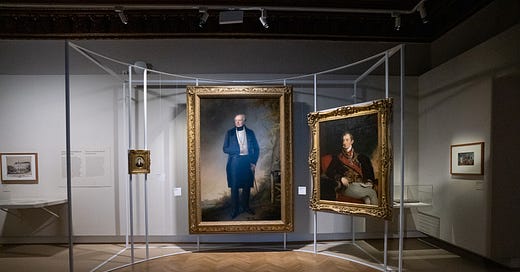Vienna and the Rothschilds
A new exhibition at Vienna's Jewish museum dives deep into the history of a family whose name has become a cliché detached from its real-world achievements
Servus!
Austria’s fourth national lockdown is at an end, the country’s museums are once more open to the public, and Vienna’s Jewish museum has an eye-catching new exhibition on the history of the Rothschilds. The family’s Austrian branch can trace its roots back to Salomon Mayer von Rothschild, born in Frankfurt in September 1774, the third child of the great banker Mayer Amschel Rothschild. In Vienna, Rothschild fils established the banking enterprise S. M. von Rothschild in Vienna in 1820, was the personal banker to chancellor Klemens von Metternich, and financed the construction of the railway network which connected Vienna to points northward in the Austro-Hungarian land empire in Bohemia, Moravia, and Galicia.
The Vienna Rothschilds were a Jewish success story. They entered the ranks of the country’s nobility; Salomon Mayer von Rothschild was granted honorary Austrian citizenship. They traveled extensively, established substantial residential holdings in Vienna including the Palais Rothschild in the city’s fourth district, and built up a vast collection of art and antiques. The Rothschilds were also a philanthropic family, donating to Vienna’s Jewish community its hospital. Salomon’s grandson, Nathaniel Meyer von Rothschild, established a foundation in his will whose proceeds would be used to found two neurological hospitals in the Austrian capital.
The Rothschilds’ downfall occurred in two stages. The first happened in the 1920s when the family bank, the Creditanstalt, became a victim of the turbulent Austrian and world economies. The bank was forced to declare bankruptcy in 1931; bailed out by the state, it was de facto government property by 1934. The second occurred after the Anschluss of March 1938. The Nazi regime held Louis Nathaniel de Rothschild for ransom, in essence, while his family’s possessions—its homes, its businesses, its paintings—were seized and Aryanized without compensation. After 1938, the Rothschilds left Austria—never to return.
Postwar, much of the Rothschilds’ art collection ended up in the hands of the democratic Austrian state. In the absence of proper processes for dealing with restitution—the Art Restitution Law was only passed in 1999—the Rothschilds were granted little compensation for works which were shared among Vienna’s art galleries from the Albertina to the Museum of Art History. The Palais Rothschild, which after 1938 had housed Adolf Eichmann’s Central Department for Jewish Emigration and was by 1945 in a state of disrepair, was torn down in the 1950s to make way for a new home for Austria’s Chamber of Labor.
“The Vienna Rothschilds. A Thriller” dives deep into the history of a family whose name has become a cliché of antisemitic conspiracy theories, entirely detached from its real-world achievements and tangible legacy. The latter is seldom visible in contemporary Vienna and too often unrecognized, as a recent legal tussle between an heir of the Vienna Rothschilds and the City of Vienna brought to light. In 2020, Geoffrey Hoguet took the City to court over its management of the Neurological Center Rosenhügel. Established by the Rothschilds, Vienna inherited the center after the War. Fearing the City was about to sell it off, Hoguet sued for—and has thus far failed to obtain—control of the trust which oversees the hospital.
Whatever the merits of his case, it is certainly true that the City of Vienna failed to live up to certain obligations to recognize the role of the Rothschilds in establishing the center. As a recent historical commission set up by the City concluded, in 1963, an agreement concerning the hospital stipulated that “the name Nathaniel von Rothschild should be displayed as Founder together with the date of establishment of the Foundation on each pavilion” at the hospital “‘in a structurally suitable form.’ As far as has been found out so far, this was never carried out.” Going forward: “The generosity of Nathaniel von Rothschild should be commemorated in a manner suitable to this unique foundation and his extraordinary humanitarian act be honored appropriately.”
Bis bald!
If you know someone who might be interested in reading the Vienna Briefing, consider sharing it with them today.
Sea of Lights
More than 30,000 people formed a ‘sea of lights’ as part of a march around Vienna’s Ringstrasse on Sunday evening. The demonstration was designed to commemorate those who had died of COVID-19 since the beginning of the pandemic and pay tribute to Austria’s healthcare workers.
Stay Out, Omicron
Passengers arriving in Austria who have not had their COVID-19 booster shots or cannot produced a negative PCR test result will automatically be subject to a 10-day quarantine period. The rules apply to both double-vaccinated and recovered passengers and came into effect December 20.
Karner’s Contrition
Interior minister Gerhard Karner has met with the president of Vienna’s Jewish community, Oskar Deutsch, after the Austrian Union of Jewish Students charged him with antisemitism. In 2008, Karner accused the Social Democratic Party (SPÖ) of working with “men from America and Israel” to undermine the state.






